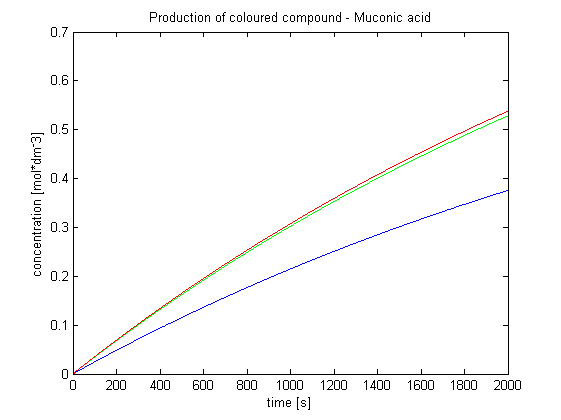Team:Imperial College London/Modelling
From 2010.igem.org
m |
m |
||
| Line 14: | Line 14: | ||
<ol> | <ol> | ||
| - | <li><b>Output Amplification Model</b><br/>We came up with an idea of using the amplification of a colour output to make it show within minutes after the stimulus has been added. The question that arose was whether amplification will actually perform better than simple production in the cellular environment. Furthermore, we had trouble deciding whether we should design the amplification module consist of 1,2 or even more amplification steps. These issues seemed to be difficult enough to employ modelling.</li> | + | <li><b>Output Amplification Model</b><br/>We came up with an idea of using the amplification of a colour output to make it show within minutes after the stimulus has been added. The question that arose was whether amplification will actually perform better than simple production in the cellular environment. Furthermore, we had trouble deciding whether we should design the amplification module to consist of 1,2 or even more amplification steps. These issues seemed to be difficult enough to employ modelling.</li> |
| - | <li><b>Surface Protein Model</b><br/>We came up with a novel idea of detecting organisms that we do not have a specific receptor for. In | + | <li><b>Surface Protein Model</b><br/>We came up with a novel idea of detecting organisms that we do not have a specific receptor for. In our particular example, the protease of Schistosoma was meant to cleave a protein displayed on the bacteria's cell wall. The cleaved peptide was supposed to be recognized by the receptor which would activate the colour expression. This solution raised questions about the risk of false positive or whether there are any chances for ComD receptors to be activated in the diluted environment. Modelling of this module would answer these questions.</li> |
</ol> | </ol> | ||
|} | |} | ||
| Line 25: | Line 25: | ||
|<b style="font-size:12px">Output Amplification Model</b><br/> | |<b style="font-size:12px">Output Amplification Model</b><br/> | ||
<ol> | <ol> | ||
| - | <li>It was concluded that there is no advantage of 2 step amplification over 1 step amplification | + | <li>It was concluded that there is no advantage of 2-step amplification over 1-step amplification. Therefore, the design of a 2-step amplifier was abandoned.</li> |
| - | <li>It could not be firmly decided whether 1-step amplification is going to | + | <li>The results concerning the 1-step amplification module were conclusive. It could not be firmly decided whether 1-step amplification is going to perform better than simple production. This is due to the slower start off which is folllowed by a sharp rise to the desirable concentration (in higher active dioxygenase concentrations).</li> |
| - | <li> | + | <li>The conditions for effective amplification were determined.</li> |
</ol> | </ol> | ||
| Line 44: | Line 44: | ||
<b style="font-size:12px">Surface Protein Model</b><br/> | <b style="font-size:12px">Surface Protein Model</b><br/> | ||
<ol> | <ol> | ||
| - | <li>Initial TEV protease concentrations we determined for the optimal activation of the receptor within 1.5 | + | <li>Initial TEV protease concentrations we determined for the optimal activation of the receptor within 1.5 minutes after elastases would have come into contact with our cell.</li> |
</ol> | </ol> | ||
<div ALIGN=CENTER> | <div ALIGN=CENTER> | ||
Revision as of 08:32, 15 October 2010
| Temporary sub-menu: Output Amplification Model; Surface Protein Model; Wet-Dry Lab Interaction; Dry Lab Diary; |
| Introduction to modelling |
In the process of designing our construct two major questions arose which could be answered by computer modelling:
|
| Results & Conclusions | ||||
Output Amplification Model
|
| Quick overview of models | |||||||||
| Output Amplification Model Goals: This model was mainly developed in order to determine whether simple production is better than 1- or 2-step amplification. Further goals, contained estimation of the speed of modelled response.Elements of the system:
The aim of this model is to determine the concentration of Schistosoma elastase or TEV protease that should be added to bacteria to trigger the response. That was supposed to allow us to correlate required concentration for the activation with the concentration of Schistosoma elastase in the lake.< It is also attempted to model how long it takes for the protease or elastase to cleave enough peptides. Elements of the system:
Major assumptions:
|
 "
"








